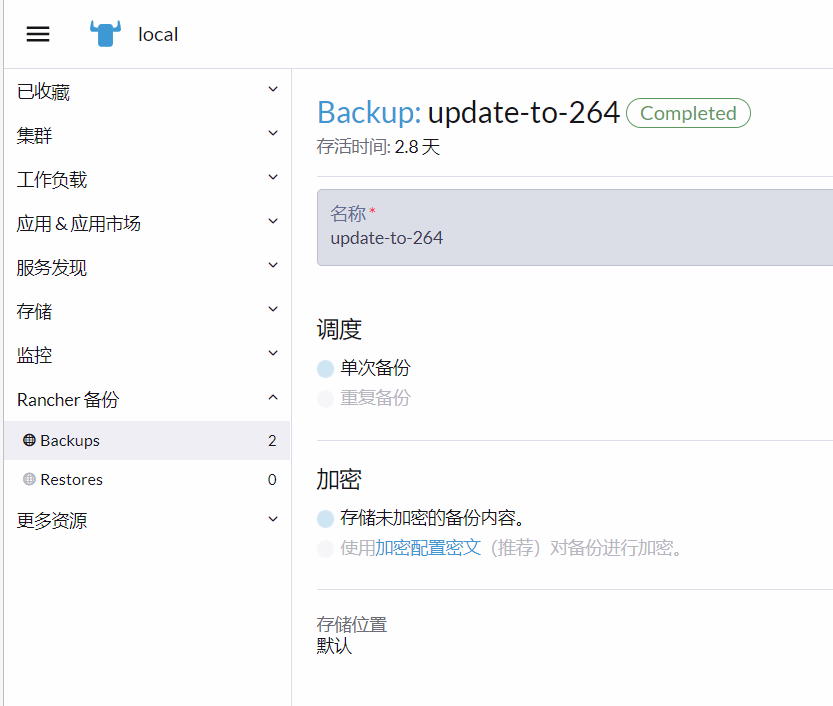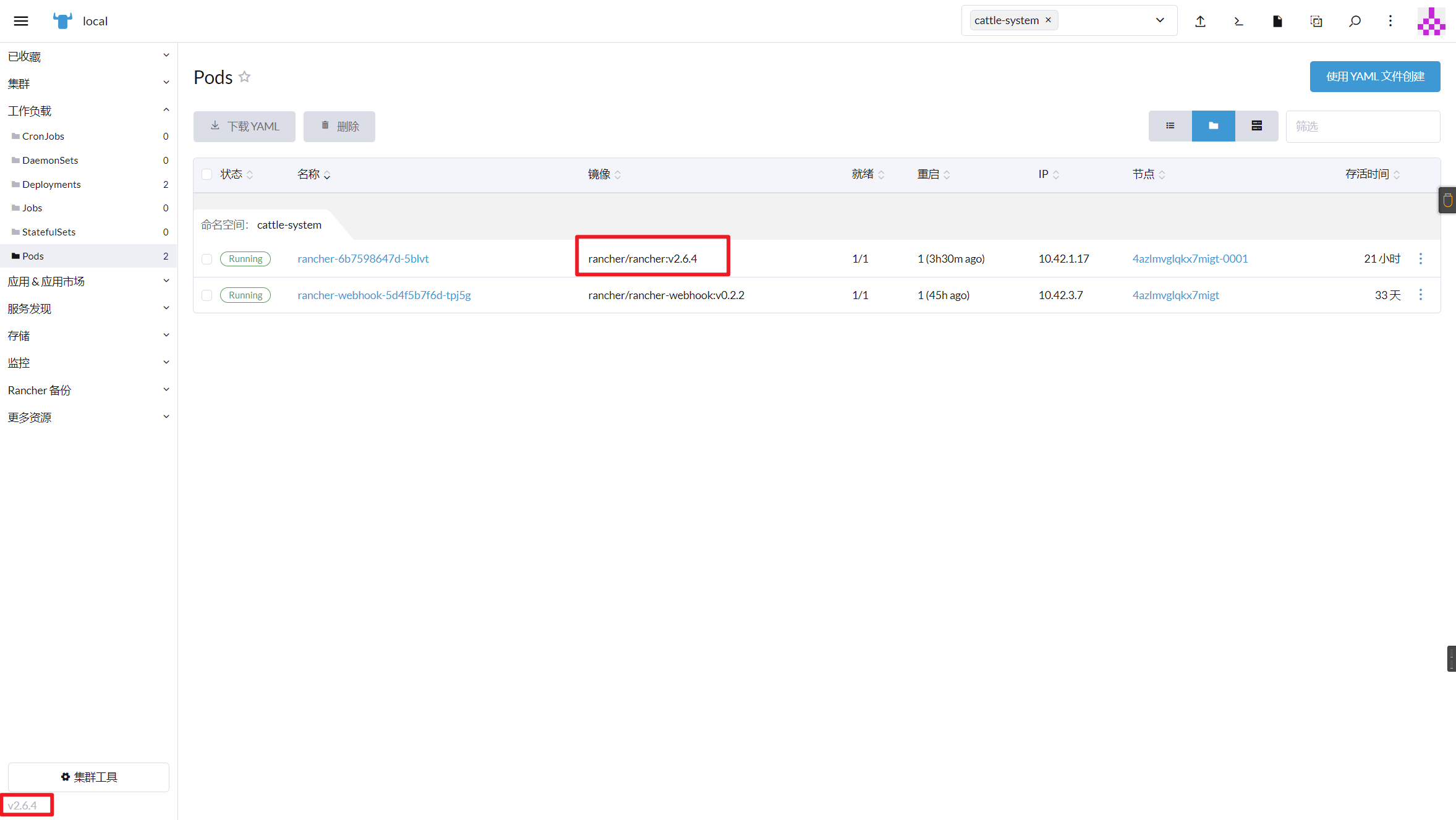Rancher Series - Rancher Upgrade
This article was last updated on: February 7, 2024 pm
overview
Previously, a 1 master (and etcd) 3 node K3S cluster was installed on 4 machines, and Rancher version 2.6.3 was installed on Helm.
A few days ago, I found that the latest version officially recommended by Rancher is:v2.6.4
So it was decided to upgrade the Rancher and K3S clusters one after another.
According to official recommendations, it is planned to:
- Upgrade Rancher from v2.6.3 to v2.6.4
- Upgrade the K3S cluster from v1.21.7+k3s1 to v1.22.5+k3s2
This article is an upgrade record for Rancher.
Related information
The basic information of Rancher in this upgrade is:
- Rancher v2.6.3
- Install online with Helm 3
- Use cert-manager(v1.7.1) + let’s encrypt to manage certificates
Upgrade steps
Back up the Kubernetes cluster running Rancher Server
use Back up the application to back up Rancher.
If something goes wrong during the upgrade process, you’ll use the backup as a recovery point.
The backup result is as follows:


Update the Helm Chart repository
-
Update the local helm cache.
1
helm repo update -
Gets the name of the repository used to install Rancher.
For more information about repositories and their differences, see Helm Chart Repositories。
- Latest: Recommended for trying out the latest features
- Stable: Recommended for production environments (📝 I use this)
- Alpha: An experimental preview of an upcoming release
Please add the
<CHART_REPO>to be replaced withlatest,stableoralpha。1
2
3
4
5
6
7
8$ helm repo list
NAME URL
bitnami https://charts.bitnami.com/bitnami
grafana https://grafana.github.io/helm-charts
aliyuncs https://apphub.aliyuncs.com
rancher-stable http://rancher-mirror.oss-cn-beijing.aliyuncs.com/server-charts/stable
prometheus-community https://prometheus-community.github.io/helm-charts -
Get the latest chart from the Helm chart library to install Rancher.
The command extracts the latest chart and uses it as
.tgzThe file is saved in the current directory. You can do this by adding--version=tag to get the chart to upgrade to a specific version. As follows:1
helm fetch rancher-stable/rancher --version=v2.6.4
Upgrade Rancher
Use Helm to upgrade Rancher’s normal (internet-connected) installation.
Get it from the currently installed Rancher Helm chart --set The value passed.
1 | |
🐾 Notes:
Because my cluster is for testing or demo purposes, so
replicasSet to 1
Append all values from the previous step to the command with --set key=value.
1 | |
4. Verify whether the upgrade is successful
Log in to Rancher and confirm that the upgrade was successful.

🎉🎉🎉
However, several problems were also found in the verification process, which are described and solved below.
Issues that occur after the upgrade
- The helm upgrade fails with an error
rendered manifests contain a resource that already exists - Managed clusters
home-k3sUnable to connect.
Helm failed to upgrade Rancher
issue
The error is reported as follows:
Error: UPGRADE FAILED: rendered manifests contain a resource that already exists.
Unable to continue with update: Secret "bootstrap-secret" in namespace "cattle-system" exists and cannot be imported into the current release: invalid ownership metadata;
label validation error: missing key "app.kubernetes.io/managed-by": must be set to "Helm";
annotation validation error: missing key "meta.helm.sh/release-name": must be set to "rancher";
annotation validation error: missing key "meta.helm.sh/release-namespace": must be set to "cattle-system"
Workaround
GitHub searched for relevant issues and found yes Bug for v2.6.4, Workaround measures:
First remove the key, then run the helm installation again:
1 | |
1 | |
Problem solving.
Managed clusters home-k3s Unable to connect
issue
Post-upgrade discovery: Managed clusters home-k3s Unable to connect, as shown below:

Log in to the managed cluster and view cattle-cluster-agent , found that the error message indicates that the format of the image is incorrect, and the image in x86_64 format is pulled.
This is because it was added when Helm was installed earlier systemDefaultRegistry=registry.cn-hangzhou.aliyuncs.com This parameter, while registry.cn-hangzhou.aliyuncs.com The image library only has images in x86_64 format, not images in arm64 format, and mine home-k3s It is installed on the Raspberry Pi 4.
Workaround
Remove Helm’ssystemDefaultRegistry=registry.cn-hangzhou.aliyuncs.com To configure, perform upgrade, as follows:
1 | |
After successful execution, it was found that Helm’s configuration had changed, but Rancher’s systemDefaultRegistry But still registry.cn-hangzhou.aliyuncs.com.
Here you find the Rancher interface shown below - set by env value:

The final finding is the configuration here:
1 | |
Delete this yaml or will value Replace it with:value: '', and restart Rancher, after the reboot takes effect, found 'registry.cn-hangzhou.aliyuncs.com' to be removed.
Problem solving.
📚️ Reference documentation
- Support matrix - Rancher v2.6.4
- Upgrade Guide | Rancher documentation
- Secret “bootstrap-secret” in namespace “cattle-system” exists and cannot be imported seen when upgrading/re-installing Rancher when bootstrap-secret is not created by Helm · Issue #37060 · rancher/rancher (github.com)
- v2.6.4 Milestone (github.com)